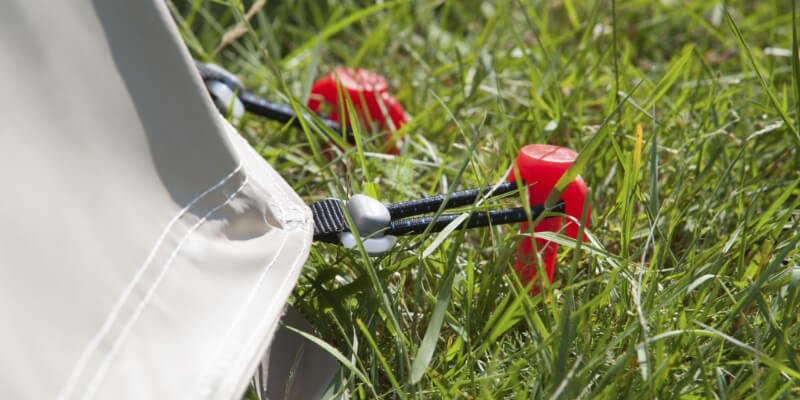
Tent pegs, also known as stakes or anchors, are an indispensable component of any camping adventure. They play a crucial role in anchoring your tent securely to the ground.
There is a wide array of tent pegs available, each designed for specific terrains, weather conditions, and tent types. Understanding the various types of tent pegs and their respective applications is essential for any camper, from the casual weekend explorer to the seasoned outdoor enthusiast.
In this guide, we’re going to discover different types of tent pegs and explain their pros and cons. So that you’ll have gained valuable insights into selecting the perfect tent pegs for your specific needs.
Wood, Plastic, Aluminum, Steel & Titanium
Wooden Tent Pegs
Tent pegs made of wood or the common wooden stake are the archetype of all pegs. It is a real natural product. Unfortunately, wooden pegs are prone to moisture. If the herrings stay in the ground longer, they will rot. Wooden pegs show further disadvantages with their high weight and large dimensions. On the plus side, there is a tight fit and they do not deform.
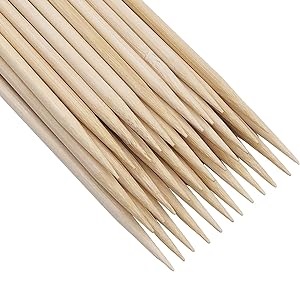
Advantages:
- Natural product
- Firm seat on the ground
- Do not deform
- Easily Replaceable
- Economical
Disadvantages:
- Susceptible to moisture
- Heavyweight
- Large dimensions
Plastic Tent Pegs
Plastic tent pegs are relatively new to the market and can actually take a lot, depending on how much polymer it contains. For a meadow long plastic pegs, they are less suitable for harder soils or rocks.
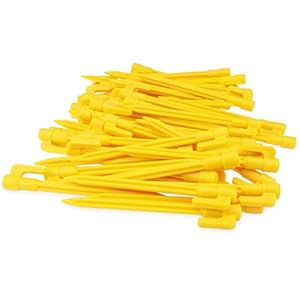
Advantages:
- Lightweight
- Low prices
- Good for soft floors
- Water and corrosion-resistant
Disadvantages:
- Not necessarily durable
- Unsuitable for hard floors
Aluminum Tent Pegs
Aluminum tent pegs are also quite light compared to wooden ones, but they are still durable. Therefore, aluminum pegs are the ideal compromise for longer trekking tours. However, since aluminum pegs bend easily, they are not suitable for rock.
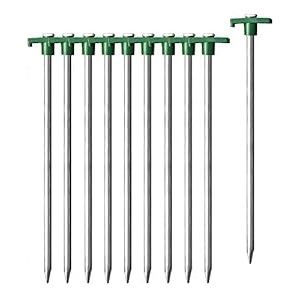
Advantages:
- Lightweight
- Relatively durable
- Easy to carry
- Suitable for hard ground
Disadvantages:
- Pegs – bend quite easily
- Softer than steel
Steel Tent Pegs
Steel tent pegs are the strongest, but also the heaviest pegs on the market. But steel pegs are cheap, and especially as tent pegs, it is almost indestructible.
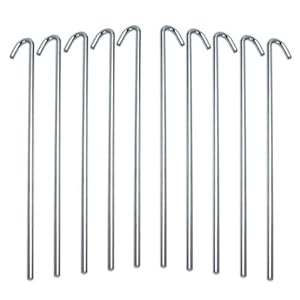
Advantages:
- Cheap price
- Extremely stable
- Resistant to bending or breaking
- Suitable for most ground
Disadvantages:
- The heaviest variant
- Sheet steel is less durable
Titanium Tent Pegs
Titanium tent pegs are also extremely robust and light compared to steel pegs. In fact, titanium pegs are the lightest pegs around. However, Titanium pegs are the most expensive on the market. You have to pay up to 20 dollars for a Titanium herring.
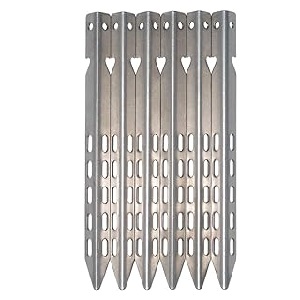
Advantages:
- Very light
- Extremely robust
- Corrosion-resistant
- Suitable for various terrains
Disadvantages:
- Extremely expensive
- Can bend under extreme pressure
Nail, Rock Herring & Screw Peg
Tent Nail
The tent nail is a basic, cost-effective, round steel peg that typically comes as a standard accessory. This type of tent peg is good for the campsite meadow but struggles with tougher terrain like rocky areas or areas with roots. The tent nail is also not an option on soft or damp floors. So get yourself real herrings.
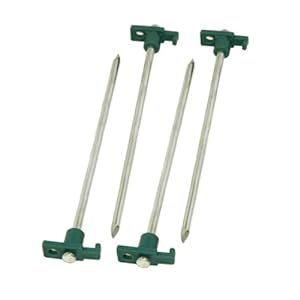
Advantages:
- Lightweight
- Very affordable price
- Easily hammered into the ground
- Easy to pull out of the ground
Disadvantages:
- Easy to bend
- Little hold on soft/damp floors
- Poor hold on wind and storms
Rock Herring
The rock herring is basically not much more, but it is longer and above all more stable. Because it is made of top-grade steel. Sometimes rock pegs even come with a thread, which you can literally screw these pegs into the rock.
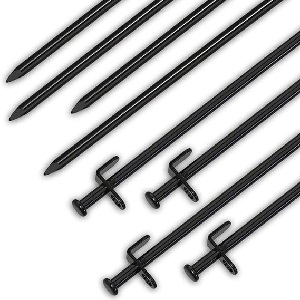
Advantages:
- Strong and reliable
- Great for hard/rocky soils
- Does not bend even when hammered in
- Provides secure anchoring
Disadvantages:
- Relatively long (pack size)
- Heavier than standard tent pegs
Screw Peg
The screw peg goes a step further and is pimped with a thread from top to bottom. Accordingly, you can screw this peg into the ground like a screw. Therefore, screw pegs are sometimes even provided with an Allen key, which sometimes makes this peg a bit unwieldy. Because you need tools. For this reason, you get screw pegs made of plastic or steel and therefore suitable for almost all ground floors.
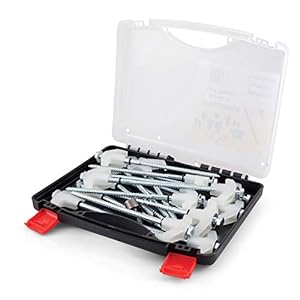
Advantages:
- Long-lasting
- Excellent grip in soft soil
- Versatile and adaptable
- Easy to screw into the ground
Disadvantages:
- Quite expensive
- Sometimes tools are required
- Less effective in rocky or hard terrain
Tent Pegs: V-pegs
Peg with a V-profile
The peg with a V-profile or folded peg is held in an angle or V-shape. This type of peg can withstand higher forces – especially on loose or damp ground – which promotes the stability of your tent. However, you should pay attention to the material the manufacturers use. In general, V-pegs are made from cheap sheet metal that buckles quickly. Sharp edges are also a risk of injury, especially barefoot at night. So pay attention to the material thickness (at least 1 mm) and spend a few dollars more.
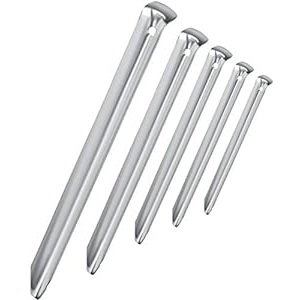
Advantages:
- Good for loose/damp soils
- Cannot rotate in the soil
- Enhanced load-bearing capacity
- Minimized ground displacement
Disadvantages:
- Cheap products tend to kink
- Sometimes very long (30 cm)
- Sharp edges (risk of injury)
Fluted V-peg
The fluted V-peg is based on the “normal” V-shaped peg, but it is wider and fluted. This tent peg is therefore ideally suited for sandy soils or meadows. Because it is not so easy to pull out of the ground because of its corrugation. A fluted herring is also a great option in strong winds or storms.
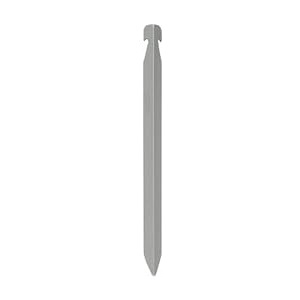
Advantages:
- Very good for sand and meadows
- Difficult to pull out of the ground
- Good for storm bands
Disadvantages:
- Not suitable for stony soils
- Care should be taken again with the material
Y-profile & Snow Pegs
Cross-section of the Y-profile Peg
The cross-section of the Y-profile peg is a kind of half-star. Because the Y-peg has a third strut compared to the V-peg. This makes the Y-peg an all-rounder that is suitable for almost all floors with the exception of rock. From then on, the Y-peg is mostly made of aluminum, which promises little weight. Nevertheless, the Y-profile is considered very stable and twist-proof.
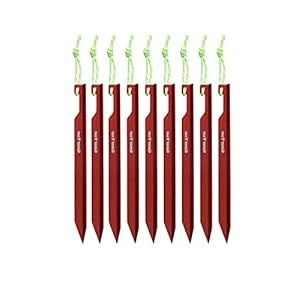
Advantages:
- Stable and durable
- All-rounder for (almost) all floors
- Usually very light (aluminum)
Disadvantages:
- Sometimes quite long
- Not suitable for rock
- Quite expensive
Snow Herring
The snow herring or snow peg is specially designed for snow. These pegs are also good for sandy ground. It is half-round (U-shape), extra-wide (3 to 5 cm), and extra-long (25 to 50 cm) – and has holes. On the one hand, these serve to save weight and give the snow ring more support. Because the compressed snow freezes in the holes, which makes the anchoring more stable.
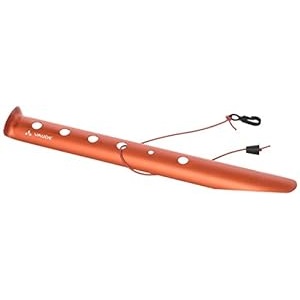
Advantages:
- Ideal for snow
- Stable and resilience
- Can also be used as a T-anchor
Disadvantages:
- Extremely large
- Pretty much heavy
T-shaped Peg
The T-shaped peg actually looks like a T at the top. This shape makes the herring extremely impact-resistant and virtually indestructible. T-pegs are mostly made of steel. Its size of up to 40 cm and its material make it damn heavy (up to 300 g each). Accordingly, pegs with a T-profile are more for campers and not an option for trekkers.
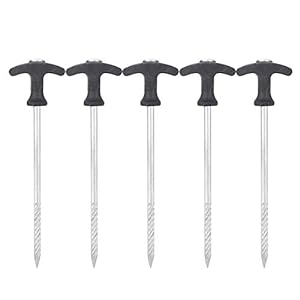
Advantages:
- Extremely impact-resistant
- Practically indestructible
- Suitable for almost all floors
- Easy to use
Disadvantages:
- Very long
- Sometimes very heavy
- Not suitable for trekkers
Practical Tips: Find Out Beforehand
Now you’re probably asking which tent stake is the right one for your next camping or hiking tour. If you don’t know the conditions, in other words, the floors, you should use Y-pegs. A few rock nails are also good in the mountains. However, if you know the conditions, you will of course pack the appropriate tent pegs.
But sometimes you also have to improvise. You may not even be able to cope with rock pegs in the mountains. Then trees, rocks, or boulders have to be used to brace your tent.
In the snow, T-anchors are again an option, i.e. pegs dug crosswise. The holes in the snow peg prove to be practical here because a cord with a carabiner is often attached to the central one. So you can countersink the snow peg as a T-anchor.
- Another tip: You don’t have to buy a set of tent stakes now. Instead, you’ll find sets that contain different pegs including a practical tent hammer, peg jack, and guy ropes.
How to Use Tent Pegs Properly!
Finally, a few tips apply for the correct use of the pegs are always a good idea. Because the best tent pegs will not do you any good if you set them incorrectly. So how are you doing? Let’s see…
45 degrees
The most important rule is, do not sink the pegs vertically into the ground. But at an angle of 45 degrees, at which the sunken endpoints to the tent. In this way, the pegs hold optimally in the ground and therefore keep your tent stable.
Tent seam
When setting up the tent, align the pegs with the guy ropes to match the tent seam. This helps prevent creases in the tent fabric.
Tent hammer
By the way, a tent hammer is good to help here. These are also equipped with a peg puller at the lower end. So you can easily pull the pegs out of the ground again.
Sink 100 percent
Sink the pegs 100 percent, i.e. completely. First, you avoid nasty stumbling blocks at night. Second, pegs with a hook on the top will no longer rotate like this.
Cross
If you want to anchor a free-standing or dome tent optimally, brace it crosswise. So first one corner, then the opposite. This is how you distribute the tension evenly. In the case of a non-free-standing tent or tunnel tent, you first tension the rear end, then the front, and finally the middle.
You generally unfasten zippers in a criss-cross pattern. This is how you keep them tension-free. So you can open it without any problems and, above all, close it again.
Other Reasons to Carry Tent Pegs
By the way: pegs are good for a few other and quite practical things when trekking and camping. For example…
- Cooking: Sunk you around a little fire, have a few pegs in a circle you have a prima Cooking for pot or pan.
- Peg puller: If one of the pegs has a hook or a hole, you can use it as a peg puller for other pegs.
- Coconut: You can also open coconuts with a herring and a tent hammer. Or a bottle of wine.
- Hanging gear: You can use tent pegs to create makeshift hooks or hangers for items like lanterns, bags, or wet gear.
- Building camp furniture: With some creativity, pegs can be used to fashion basic camp furniture like tables or chairs.
- Creating a washing line: Pegs can be used to set up a line for drying wet clothes or gear.
Conclusion
You already know that pegs are primarily used to secure the tent while camping, hiking, or in other outdoor activities where you need to set up a tent. After all, this should and must be stable in the wind or even storms. When not in use, you can use a couple of tent pegs for other purposes. So storing a stable set of tent pegs is always a good idea.
Hope our guide on different types of tent pegs helped you to find a suitable model. Do you have any other ideas? Then post a comment!
Do you like this article? Then share it on the social web. Thank you so much!
Read Also: